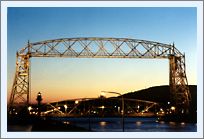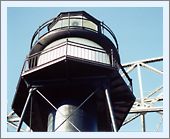|
Historical Information

With the establishment of the Duluth South Breakwater Light in 1874 the
task of locating Duluth harbor was much simplified. However, with only
300 feet between the north pier and the south breakwater, identifying
the correct entry course that would place a vessel smack dab between
them was somewhat risky.
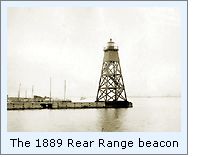 To rectify this situation, in 1880 the
Lighthouse Board recommended that the sum of $2,000 be made available
for the construction of a light on the inner end of the south
breakwater. By constructing this new tower with a focal plane higher
than that of the existing breakwater light, the two lights would combine
to serve as a range, and by maintaining a line in which these two lights
were constantly oriented one above the other, a direct course could be
followed to the opening between the two piers. To rectify this situation, in 1880 the
Lighthouse Board recommended that the sum of $2,000 be made available
for the construction of a light on the inner end of the south
breakwater. By constructing this new tower with a focal plane higher
than that of the existing breakwater light, the two lights would combine
to serve as a range, and by maintaining a line in which these two lights
were constantly oriented one above the other, a direct course could be
followed to the opening between the two piers.
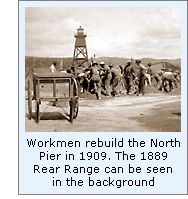 After receiving a Congressional
appropriation on March 2,1889, construction began on a timber pyramid
tower surmounted by a frame watch room. Topped with an octagonal cast
iron lantern, and equipped with a flashing red Fourth Order Fresnel lens
emitting a single flash every six seconds, the "sweet pot" of
which was situated at a focal plane above that of the South Breakwater
Light. After receiving a Congressional
appropriation on March 2,1889, construction began on a timber pyramid
tower surmounted by a frame watch room. Topped with an octagonal cast
iron lantern, and equipped with a flashing red Fourth Order Fresnel lens
emitting a single flash every six seconds, the "sweet pot" of
which was situated at a focal plane above that of the South Breakwater
Light.
Work on the new structure continued
through the summer, and the new rear range light was exhibited for the
first time on the night of September 1. Sixteen days later, on September
17, the steamer India was encountering some problems making her way
between the piers, and smashed into the breakwater at the foot of the
new light, damaging the light's foundation. Repairs were made quickly at
the expense of the vessel's owners.
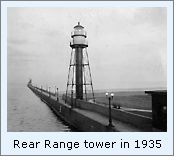 By 1897, Duluth had grown to become one
of the Great Lake's preeminent ports, and the town was expanding rapidly
to envelope the hills surrounding the natural harbor. With the resulting
proliferation of city lights, mariners voiced concern that the lights of
the range were becoming increasingly difficult to differentiate from
those of the city, and the Lighthouse Board contemplated increasing
their visibility by substituting lenses of a higher order, or changing
their characteristics to something more readily identifiable. By 1897, Duluth had grown to become one
of the Great Lake's preeminent ports, and the town was expanding rapidly
to envelope the hills surrounding the natural harbor. With the resulting
proliferation of city lights, mariners voiced concern that the lights of
the range were becoming increasingly difficult to differentiate from
those of the city, and the Lighthouse Board contemplated increasing
their visibility by substituting lenses of a higher order, or changing
their characteristics to something more readily identifiable.
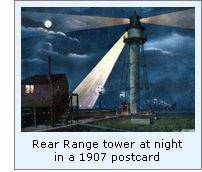 In the summer of 1901, the iron work
for the permanent tower was delivered, and work began with the
installation of two large concrete blocks within the breakwater to serve
as its foundation. The structure itself consisted of an eight foot
diameter iron cylinder containing a spiral cast iron stairway. Atop this
cylinder, a galvanized iron gallery with circular watch room was
supported by four tubular legs radial to the central cylinder, and
diagonally braced with struts and tension rods. Capped with an octagonal
cast iron lantern, the structure stood seventy feet from the base of the
cylinder to the top of the ventilator ball, and provided the Fourth
Order Fresnel lens with a focal plane of 68 feet. To provide a measure
of visual contrast and improve the station's function as a day mark, the
lantern and watch room were painted black, with all remaining components
painted a bright white. In the summer of 1901, the iron work
for the permanent tower was delivered, and work began with the
installation of two large concrete blocks within the breakwater to serve
as its foundation. The structure itself consisted of an eight foot
diameter iron cylinder containing a spiral cast iron stairway. Atop this
cylinder, a galvanized iron gallery with circular watch room was
supported by four tubular legs radial to the central cylinder, and
diagonally braced with struts and tension rods. Capped with an octagonal
cast iron lantern, the structure stood seventy feet from the base of the
cylinder to the top of the ventilator ball, and provided the Fourth
Order Fresnel lens with a focal plane of 68 feet. To provide a measure
of visual contrast and improve the station's function as a day mark, the
lantern and watch room were painted black, with all remaining components
painted a bright white.
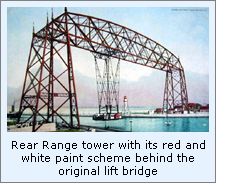 With two lights and a frequently active
fog signal, a head keeper and two assistants were assigned to the Duluth
Light station. However the only dwelling available to the crew was the
small frame house built for the keeper in 1874. As a result, the two
assistant keepers were forced to rent their own dwellings in town, at a
cost of $10 and $15 per month, a considerable cost to those earning the
less than princely sums that the position afforded. Thus, the Lighthouse
Board requested an appropriation of $10,000 for the purchase of land and
the construction of a duplex dwelling in the area of the rear range for
the assistants and their families in its 1903 annual report. With two lights and a frequently active
fog signal, a head keeper and two assistants were assigned to the Duluth
Light station. However the only dwelling available to the crew was the
small frame house built for the keeper in 1874. As a result, the two
assistant keepers were forced to rent their own dwellings in town, at a
cost of $10 and $15 per month, a considerable cost to those earning the
less than princely sums that the position afforded. Thus, the Lighthouse
Board requested an appropriation of $10,000 for the purchase of land and
the construction of a duplex dwelling in the area of the rear range for
the assistants and their families in its 1903 annual report.
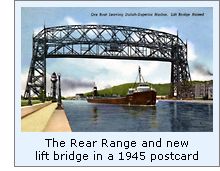 Congress ignored the request, however
the Board did not give up easily, reiterating its request every year
until an appropriation of $2,000 for the purchase of land was finally
made on March 4, 1907, with an additional appropriation for the actual
construction of the dwelling on May 27 of the following year. While an
empty lot directly across Lake Avenue from the head keepers' dwelling
was selected, there was some wrangling required in order to obtain
Government title to the property, and the structures were thus not
completed and occupied until February, 1913. As completed, the building
consisted of a two story brick duplex structure with a roof of asbestos
shingles. Replete with all conveniences of the day, the first floor of
each apartment consisted of an entry vestibule, living room, dining
room, kitchenette and pantry. With two bedrooms and a bath on the second
floors, the entire structure was heated by a hot-water heating system
located in the cellar. Both dwellings are still standing, and can be
seen flanking Lake Avenue immediately to the east of the aerial lift
bridge. Congress ignored the request, however
the Board did not give up easily, reiterating its request every year
until an appropriation of $2,000 for the purchase of land was finally
made on March 4, 1907, with an additional appropriation for the actual
construction of the dwelling on May 27 of the following year. While an
empty lot directly across Lake Avenue from the head keepers' dwelling
was selected, there was some wrangling required in order to obtain
Government title to the property, and the structures were thus not
completed and occupied until February, 1913. As completed, the building
consisted of a two story brick duplex structure with a roof of asbestos
shingles. Replete with all conveniences of the day, the first floor of
each apartment consisted of an entry vestibule, living room, dining
room, kitchenette and pantry. With two bedrooms and a bath on the second
floors, the entire structure was heated by a hot-water heating system
located in the cellar. Both dwellings are still standing, and can be
seen flanking Lake Avenue immediately to the east of the aerial lift
bridge.
In 1995, an inspection of the Fourth
Order Fresnel lens showed that it was in dire need of repairs, and thus
the Coast Guard decided to replace the old lens with a modern acrylic
optic, and donated the Fresnel to the Maritime Museum. The lens was
subsequently restored and the pedestal and clockwork rotating mechanism
were removed from the tower to be reunited with the lens. Today, both
may be seen on display in the Knowlton Gallery within the Museum. Today,
the colors of the rear range light have been reversed, with the central
cylinder and support legs now painted black, and the watch room white.

Keepers of
this Light

Click
here to see a complete listing of all keepers of the Duluth
Lights compiled by Phyllis L. Tag of Great Lakes Lighthouse Research.

Seeing these
Lights
Duluth turned-out to be
the big surprise of this yearís trip. We expected a dismal & dirty
port city, with nothing to keep our attention beyond the three lights on
the harbor pier. Were we in for a real surprise! The entire downtown and
waterfront area has been through a major renovation, and there was a ton
of things to do.
 All three lighthouses are on piers on either side of a canal that was
cut through a huge sand spit which protects the harbor on which the city
is built. The road across the canal is accommodated by the Duluth lift
bridge, which was built in 1902, and being one of Superiorís busiest
ports, both Lakers and Salties are coming and going throughout the day. All three lighthouses are on piers on either side of a canal that was
cut through a huge sand spit which protects the harbor on which the city
is built. The road across the canal is accommodated by the Duluth lift
bridge, which was built in 1902, and being one of Superiorís busiest
ports, both Lakers and Salties are coming and going throughout the day.
While on the North
pier, we visited the Canal Park Maritime Museum, which is run by the
Army Corps of Engineers, and located tight against the lift bridge. We
found this to be a fascinating museum, and is the current location of
the Fourth Order Fresnel lens formerly located in the rear range
lantern. Museum hours vary
by season. Summer hours generally are 10 a.m. to 9 p.m. daily; Spring
and Fall hours are 10 a.m. to 4:30 p.m. daily, and Winter hours are 10
a.m. to 4 p.m. Friday through Sunday. For more information, call the
museum at (218) 727-2497

Finding these Lights

Hwy 61 slices through Duluth parallel to the lakeshore. All three Duluth
lighthouses are located on piers protecting the canal through a long
sand bar which protects the Port of Duluth, and are all located in
an area known as Canal Park, which is well signed. From Hwy 61, take
Canal Park Drive into Canal Park drive, and find a place to park before
crossing the famous lift bridge. The lighthouses are a short walk from
the bridge. The North Breakwater Light is located at the end of the pier
on the North side of the canal, and both South lights are (naturally)
located on the South side of the canal, which can be reached by walking
across the lift bridge. If the horn sounds followed by a message to
"clear the bridge" is heard, be sure to get off the bridge
quickly, as they do not give.

Reference
Sources
Annual reports of the
Lighthouse Board, various, 1880-1909
Annual reports of the Lighthouse Establishment, various,1910-1939
Annual report of the Lake Carriers Association, 1908
Inventory of Historic Light Stations,
National Parks Service,
1994.
The Northern Lights, Charles K. Hyde, 19995
Observation during visit to Duluth Harbor on
09/06/1999
Keeper listings for this light appear courtesy of Great
Lakes Lighthouse Research
|
